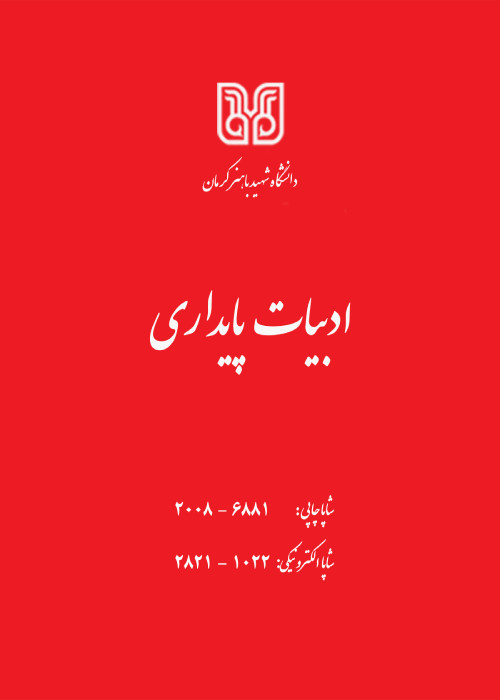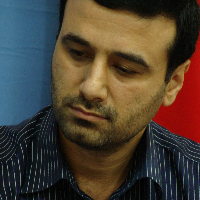Conversational Discourse in the Generational Interaction of Resistance Poetry: A Case Study of the Poem "Tehran, Tehran" Written by Andisheh Fooladvand
Literature is one of the most important fields that has a completely two-faceted face in influencing and being influenced by social phenomena. Events such as war have been shown in many literary texts of different nations, and writers and poets have reacted with a sympathetic attitude to the nation's resistance or protest against the beginning and continuation of the war. From the total literature of a country, there are stories or poems that can be classified as military fiction based on the subject. This type of literature often occurs during a war whose history has also passed" (Hanif, 2009: 293). Looking at the poetry of the Islamic revolution in Iran, it can be determined that after the end of the eight-year war and the country's entry into the atmosphere of general reconstruction, art and literature also experienced a new stage and new conditions (Kafi, 2005: 185-187). At the macro level, naming events such as war has a meaningful relationship with the quality and strength of nations in facing hardships and victories and preserving national identity. While war as a part of human life is a platform for the creation of artwork and it cannot be considered apart from the flow of life. On the other hand, with the change of generational objects, the methods of transferring concepts and ideas also change. One of the ways to investigate and analyze the change in discourses and approaches in the transfer of thought is "descriptive analysis" of the works published today for the current generation. Unlike the "Historical" method, this descriptive method does not pay attention to the evolution of the literary work throughout history, but tries to describe the functional angles of the work based on linguistic actions.
In this article, the poem "Tehran, Tehran" written by "Andisheh Fooladvand" in the collection "Shoot Buddy" (2013) is analyzed with a descriptive analytical method and from the perspective of "cognitive discourse". In this approach, the relationship between discourse, conversation and cognition, that is, the relationship between textual discourse structure on the one hand and the mental activities of processing, storing and retrieving information on the other hand, is described by using discourse knowledge and "cognitive applied science" analysis.
In order to introduce the metaphorical context of the poem "Tehran, Tehran", we discussed how concepts such as patriotism, war, resistance, etc. are constructed in the field of sustainable literature. The purpose of this study is to show the capacities of text representation in the discourse of the participants in the discourse. A discourse that has been from the first generation of revolution and war and is considered a narrator of contemporary historical events.Following Chief (1994), Tomlin and others (1997) relied on a kind of epistemology of dialogue by raising the issue of conversational discourse. which deals with the study of linguistic realms, existence, dimensions of knowledge and human linguistic capacities to control the flow of information and understand the truth of the world. Diane Pontrotto, (2013) in an article titled "Cohesive role of cognitive metaphor in conversational discourse" pointed out the speaker's ability to control the flow of information at four levels. According to Tomlin and Pontrotto, the conversation and flow of information exchange is placed in the field of cognition. In other words, the concepts during the production and reception of conversational discourse are based on mutual understanding (going back and forth) that appear in the four levels of information flow. These four levels are 1. Rhetorical level, 2. Referential level, 3. Thematic level, 4. Focus level. In these four levels, the narrator (poet) uses hidden correspondences in language to create ontological concepts and intellectual knowledge with the audience (Pontroto, 2010: 335-335). His goal is not the mere significations of "in time", in other words, he does not simply refer to the generational relations and values of his time, but rather speaks of a category that has an active and fruitful member in the context of the audience's society. Because he knows that the reduction of verbal communication causes a disruption in the identification process, a reduction in emotional commonalities, a lack of commitment to one's own culture, and generational intolerance (Sharfi, 2003:112).
The social world is a product of discourses, and every discourse is trying to establish its meanings; Which signifier wins depends on the signifiers that are used in various discourses. The analysis and analysis of Tehran's poetry with the approach of conversational discourse shows that "Foolavand" has created a two-way interaction of metaphorical and musical concepts due to the appropriate use of natural language and the right knowledge of the way of knowing and talking for the third generation discourse and has produced stable hegemony by advancing certain signs. The narrator of the poem, who has understood the period of eight years of stability, as a representative of a generation that has sent its childhood to "quarantine", understanding the social context of today's society, he speaks knowingly about the troubles of the age, including chaos, doubt and crisis, smoke and prosperity, etc., to make the audience agree with him. By expressing these signs in the social context of the poem, he takes the reader to the artistic context so that all generations who are in a new discourse space, have the same ideals as the first generation. Linguistic signs in the use of spoken language, such as: There, the question, I know, etc., have distinguished poetry from the formal context of language. Using music, imagery, rhyme and tone, the poet has brought the style of today's discourse to the stage in order to create the audience's connection for discourse empathy.
- حق عضویت دریافتی صرف حمایت از نشریات عضو و نگهداری، تکمیل و توسعه مگیران میشود.
- پرداخت حق اشتراک و دانلود مقالات اجازه بازنشر آن در سایر رسانههای چاپی و دیجیتال را به کاربر نمیدهد.



